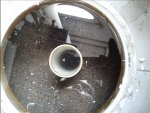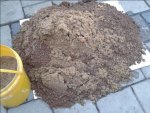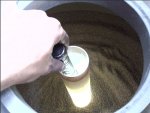I'd posted a couple weeks back about a problem with water that remained stubbornly cloudy, despite good, healthy, balanced numbers. I got the advice to examine for filtration issues. I thought I'd share the success story in case it helps anyone else out there...
I'm using a 200# Hayward top valve sand filter, which I switched from sand to Zeobrite at the start of the 2009 season. Was very happy with the filtration results last year, but noticed that my pressure did not increase over time the way it did with sand. As a consequence, I rarely backwashed... which I think may have been part of the problem. My bather load is not terribly heavy, and the automatic cover is usually only rolled back when the pool is in use.
The project unfolded over the course of several days. At the very start, I thoroughly backwashed, and then popped the top off the filter. Despite backwashing, there was as very surprising amount of junk on top of the media. I started rising the Zeo inside the filter with a garden hose, filling it up and letting it overflow over the top. I was able to rinse a fair amount of funky brown stuff out of the filter this way, but it was an incredibly tedious, time-consuming process that wasted a lot of water. After spending a few hours over the course of a couple of days messing around this way, I concluded this was a poor use of my time (I already knew I could dump the Zeo and go to fresh sand for about $35). I decided to give it one more try to fix this, and to do so mostly in the name of science (and also in keeping this nearly-new, expensive Zeobrite out of the landfill). I needed a nuclear option.
I came across this article about regenerating Zeolite annually on the mfr website:
http://www.zeobrite.com/PDF/Zeobrite%20 ... cedure.pdf
I devised my own procedure that combined the above with a media remove/wash/replace process. So at 1:00 pm Friday, I began draining the filter and scooping out the media into a wheelbarrow lined with landscape fabric. Once empty, I removed the stand tube/lateral assembly. I carefully washed it all (even scrubbed the laterals clean with a soft vegetable scrubbing brush) and examined laterals for any sign of cracks or breakage. All the hardware checked out.
I fashioned a wash filter out of a second piece of landscape fabric and some zip ties. I began the process of moving small batches of the media into the wash filter and rinsing it out with fresh water from the hose (envision a giant tea bag), until the water ran nearly clear (completely clear took a lot more time & water -- and I was going to follow up with the regenerative procedure anyway). These batches went back in to the filter container (which had the sparkling clean lateral assembly reinstalled and had been filled halfway with fresh water. After reloading the media into the filter, the water inside looked surprisingly cloudy. I mixed up my regenerative solution according to the Zeobrte instructions above (salt + water + filter bed cleaner), and put all into the filter. This process was completed around 3:00 pm (elapsed time: 2 hours).
I let the solution soak in the media for about 4.5 hours. So around 7:30 pm, I buttoned the filter back up and backwashed the mess inside to waste. After the glass ran clear, I rinsed the valve, and then backwashed again (per the instructions above). So by 8:00, I was filtering again as normal. I closed up the automatic cover and went inside to enjoy a beverage and change channels.
Interestingly, after all this rinsing and cleaning, my 'fresh' psi stayed at 17, exactly where it was before I started. Really, where it always is. Since going to Zeo, my pressure virtually never changes.
We went out of town Saturday. So upon returning home Sunday afternoon, I rushed out back and rolled back the cover. And there she was, in all her glory. The sparkle had returned.
I think the most important lesson I'm taking from all this is to not wait until I have an appreciable increase in pressure before backwashing. The 3 - 4 psi increase was a great rule of thumb with sand... but for some reason it does not seem to apply to my system with Zeo. I probably will also make the regenerative process an annual exercise (skipping the remove/wash/replace bit... that kind of sucked). The next couple of years will determine whether I stay with Zeo or go back to sand.
Thanks all, for the help & support.
I'm using a 200# Hayward top valve sand filter, which I switched from sand to Zeobrite at the start of the 2009 season. Was very happy with the filtration results last year, but noticed that my pressure did not increase over time the way it did with sand. As a consequence, I rarely backwashed... which I think may have been part of the problem. My bather load is not terribly heavy, and the automatic cover is usually only rolled back when the pool is in use.
The project unfolded over the course of several days. At the very start, I thoroughly backwashed, and then popped the top off the filter. Despite backwashing, there was as very surprising amount of junk on top of the media. I started rising the Zeo inside the filter with a garden hose, filling it up and letting it overflow over the top. I was able to rinse a fair amount of funky brown stuff out of the filter this way, but it was an incredibly tedious, time-consuming process that wasted a lot of water. After spending a few hours over the course of a couple of days messing around this way, I concluded this was a poor use of my time (I already knew I could dump the Zeo and go to fresh sand for about $35). I decided to give it one more try to fix this, and to do so mostly in the name of science (and also in keeping this nearly-new, expensive Zeobrite out of the landfill). I needed a nuclear option.
I came across this article about regenerating Zeolite annually on the mfr website:
http://www.zeobrite.com/PDF/Zeobrite%20 ... cedure.pdf
I devised my own procedure that combined the above with a media remove/wash/replace process. So at 1:00 pm Friday, I began draining the filter and scooping out the media into a wheelbarrow lined with landscape fabric. Once empty, I removed the stand tube/lateral assembly. I carefully washed it all (even scrubbed the laterals clean with a soft vegetable scrubbing brush) and examined laterals for any sign of cracks or breakage. All the hardware checked out.
I fashioned a wash filter out of a second piece of landscape fabric and some zip ties. I began the process of moving small batches of the media into the wash filter and rinsing it out with fresh water from the hose (envision a giant tea bag), until the water ran nearly clear (completely clear took a lot more time & water -- and I was going to follow up with the regenerative procedure anyway). These batches went back in to the filter container (which had the sparkling clean lateral assembly reinstalled and had been filled halfway with fresh water. After reloading the media into the filter, the water inside looked surprisingly cloudy. I mixed up my regenerative solution according to the Zeobrte instructions above (salt + water + filter bed cleaner), and put all into the filter. This process was completed around 3:00 pm (elapsed time: 2 hours).
I let the solution soak in the media for about 4.5 hours. So around 7:30 pm, I buttoned the filter back up and backwashed the mess inside to waste. After the glass ran clear, I rinsed the valve, and then backwashed again (per the instructions above). So by 8:00, I was filtering again as normal. I closed up the automatic cover and went inside to enjoy a beverage and change channels.
Interestingly, after all this rinsing and cleaning, my 'fresh' psi stayed at 17, exactly where it was before I started. Really, where it always is. Since going to Zeo, my pressure virtually never changes.
We went out of town Saturday. So upon returning home Sunday afternoon, I rushed out back and rolled back the cover. And there she was, in all her glory. The sparkle had returned.
I think the most important lesson I'm taking from all this is to not wait until I have an appreciable increase in pressure before backwashing. The 3 - 4 psi increase was a great rule of thumb with sand... but for some reason it does not seem to apply to my system with Zeo. I probably will also make the regenerative process an annual exercise (skipping the remove/wash/replace bit... that kind of sucked). The next couple of years will determine whether I stay with Zeo or go back to sand.
Thanks all, for the help & support.



 and glad you got it sparkling clean again.
and glad you got it sparkling clean again.

